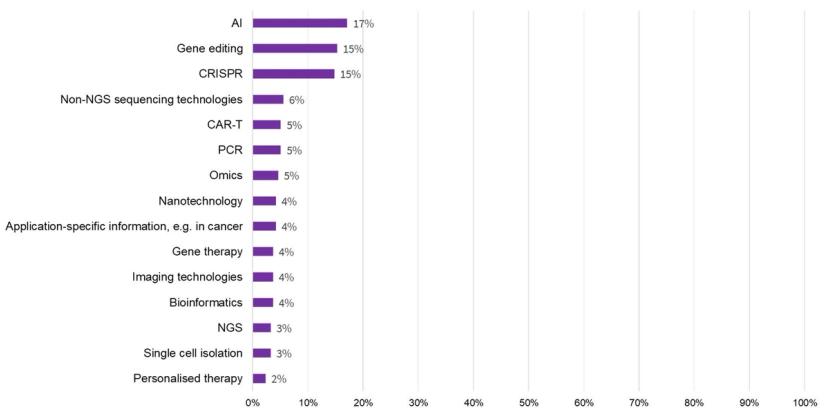Tech drives change and learning in cell and gene therapy
A survey exploring the science behind cell and gene therapies highlights the tech at the heart of this breakthrough area
1 Apr 2024
The scientific community is keen to learn more about genomics, DNA sequencing and next-generation sequencing (NGS), as well as gene editing and bioinformatics, according to findings from a cell and gene therapy survey conducted by SelectScience®. The survey was conducted against the backdrop of the first gene therapy regulatory approvals coming through in recent months.
More than half of respondents (57%), who are involved across the spectrum of cell and gene therapy, want to learn more about genomics, DNA, and next-generation sequencing. They are looking to advance their current knowledge, with almost half (47%) already employing the technology in their work.

Tech changes way of working
When it comes to specific approaches, respondents felt that gene editing, specifically CRISPR, holds the most promise, reinforcing earlier findings that this is an area respondents are keen to learn more about.

Uptake of AI remains low
The survey found that only 26.3% of respondents are using AI in their work, though 17% see it as one of the most promising emerging technologies helping to advance research ahead of gene editing (15%) and, specifically, CRISPR (15%).
Given the opportunity to comment on the emerging technologies they thought were particularly promising, respondents agreed that AI would have a significant impact on cell and gene therapy research, ahead of specific cell and gene therapy approaches. Respondents commented that AI has the potential to reduce the need for early stage trials in animals, as well as help to process vast amounts of data.
Getting to grips with and incorporating new technology is taking up increasing amounts of time, say respondents, with 78.4% listing technology as a challenge for them. Of these, more than one-third (34.0%) indicated it was a significant work challenge.

Other challenges persist
The majority also have concerns about the feasibility of therapies, with 88.4% listing the development of scalable manufacturing processes as a challenge and a similar proportion (87.3%) concerned about the generation of sufficiently viable, potent, and safe products meeting patient- and disease-specific needs.
More than half of these (50.5% of the total sample) indicate that product generation is a significant challenge – a higher proportion than are intensely concerned about long-term efficacy and durability.
Despite this, the jury is still out in terms of the overall longevity of cell and gene therapy. Just over half (50.7%) see longevity as an issue, while 49.3% have no concerns about longevity. Around one in 20 (5.4%) chose to comment on why they considered longevity to be an issue.
Respondents highlighted Thermo Fisher Scientific, Agilent Technologies, and LGC Biosearch Technologies, among others, as the manufacturers they would choose for their cell and gene therapy workflow needs. Given the chance to name other important brands, Sartorius, and GenScript were mentioned as significant players in the field. Learn more about the application of the cutting-edge technologies available from some of these brands in our Cell and Gene Therapy Accelerating Science Feature >>
You can also hear what experts in the field had to say in our Accelerating Science Forum which discusses the longevity and compliance challenges of cell and gene therapy – Watch on demand.
